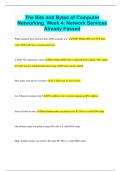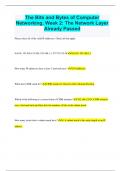The Bits and Bytes of Computer Networking
University of the People
Page 2 out of 12 results
Sort by

-
The Bits and Bytes of Computer Networking. Week 4: Network Services Already Passed
- Exam (elaborations) • 8 pages • 2023
-
- $10.49
- + learn more
What transport layer protocol does DNS normally use? UDP; While DNS over TCP does exist, UDP is the most common protocol. A DNS TTL determines what? How long a DNS entry is allowed to be cached; TTL stands for Time to Live and determines how long a DNS entry can be cached How many root servers are there? 13; There are 13 root servers. An A Record contains what? IPv4 address; An A record contains an IPv4 address Select all that are true. One domain name can point to one IP; This is a valid ...

-
The Bits and Bytes of Computer Networking. Week 2: The Network Layer Already Passed
- Exam (elaborations) • 5 pages • 2023
-
- $9.99
- + learn more
Please select all of the valid IP addresses. Check all that apply. 8.8.8.8, 123.456.123.456, 192.168.1.1, 257.70.312.49 8.8.8.8, 192.168.1.1 How many IP addresses does a class C network have? 254 addresses What does CIDR stand for? CIDR stands for Classless Inter-Domain Routing Which of the following is a correct form of CIDR notation? 192.168.1.0/24; CIDR notation uses a forward slash and then lists the numbers of bits in the subnet mask. How many octets does a subnet mask have? 4; A subn...

How did he do that? By selling his study resources on Stuvia. Try it yourself! Discover all about earning on Stuvia


